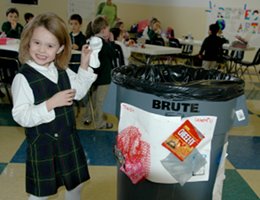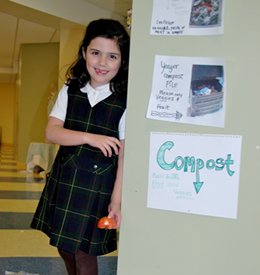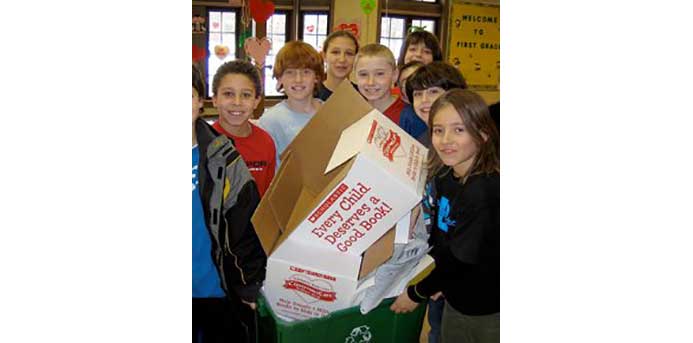I’m policing a cafeteria recycling bin, directing students like a traffic cop: “That goes in the garbage; remove that straw and put the milk carton in here; dump the mac-n-cheese before you toss the container in the blue bin.”
Welcome to Trash-Free Friday. That’s when North Shore students and nationwide are challenged to eliminate their lunchroom waste—things like plastic baggies, one-use bottles and candy wrappers. Landfills are nearing capacity and waste-removal costs are skyrocketing. And when it comes to school garbage, the cafeteria is ground zero, producing more garbage than any other area of a school combined.
According to wastefreelunches.org, a site that promotes the cause, a school-age child who packs a disposable lunch generates on average 67 pounds of waste per school year. That equates to 18,760 pounds of lunch waste for just one average-size elementary school. Wilmette’s District 39 sold 111,626 disposable water bottles to students and teachers in the 2008-09 school year.
 That’s a lot of trash. Susan Ozawa, gifted and talented resource teacher at Braeside Elementary School in Highland Park, knows only too well. Three years ago her fifth graders lobbied to start a waste-reduction program, replete with a weighing of the garbage, which they still do on a daily basis.
That’s a lot of trash. Susan Ozawa, gifted and talented resource teacher at Braeside Elementary School in Highland Park, knows only too well. Three years ago her fifth graders lobbied to start a waste-reduction program, replete with a weighing of the garbage, which they still do on a daily basis.
For a school with about 300 kids, it produces on an average day about 24 lbs. of garbage, down more than 50% from before it began recycling and worm composting a few years ago, Ozawa says.
“The kids really feel like they’re making a difference,” she says. On any given day, or one of the school’s “Litter-Less Lunch Days,” the student recycling team mans the garbage and recycling bins, helping kids sort their trash.
“They panic if a milk carton lands in the garbage,” she says, noting that she watches as her kids regularly fish Capri Sun pouches, Lay’s potato chip bags and Nabisco cookie wrappers out of the trash to save and send to TerraCycle, a company that converts trash into bags, kites and other products.
 Striving for zero waste isn’t easy, says Gina Ney, environmental awareness co-chair at Central School in Wilmette, who’s run Waste-Free Days. Instead, she says, the focus should be on reduction: Students should be urged to use reusable containers, take home nonperishable excess food, and talk to their parents about packing less or different food.
Striving for zero waste isn’t easy, says Gina Ney, environmental awareness co-chair at Central School in Wilmette, who’s run Waste-Free Days. Instead, she says, the focus should be on reduction: Students should be urged to use reusable containers, take home nonperishable excess food, and talk to their parents about packing less or different food.
In the end, Ney says, “The best recyclers come from homes that recycle.”
Want to reduce waste in schools? Here are a few resources:
- WasteFreeLunches.org: This site sells reusable lunch containers and has information on how to set up a waste-free lunch.
- SWANCC.org: The Solid Waste Agency of Northern Cook County offers resources on how to conduct a waste-free lunch, such as sample letters to send to parents to explain a waste-free lunch and tips on how to pack one. SWANCC also has $200 grants available for schools that can be applied toward waste-reduction efforts, such as buying recycling bins or worm compost bins.
- IllinoisRecycles.org: Sponsored by the Illinois Department of Commerce & Economic Opportunity, this site has resources as well as an application for the Illinois Zero Waste Schools Grant Program.
- Terracycle.net: Get paid for your trash—TerraCycle pays for everything from Capri Sun drink pouches to Lay’s potato chip bags and Elmer’s Glue bottles, which it turns into other products.
Want to make your own kid’s lunch a little less wasteful? Try this:

Laptop Lunch Bento Set 2.0 with Blue Outer Container, 5-Inner Containers, Utensils and User’s Guide

